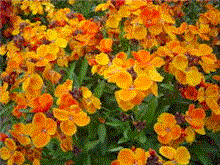|

Wallflower |
The Wallflower, or Handfiower (Cheiranthus cheiri), or Wall-gilliflower, has been cultivated in this country almost from time immemorial, for its fragrance and bright coloring. It is found wild in France, Switzerland, and Spain, as the Keiri or Wallstock. Formerly this flower was carried in the hand at classic festivals. Herrick, in 1647, gave a more romantic origin to the name Wallflower:
|
"Why this flower is now called so
List, sweet maids, and you shall know:
Understand this wilding was
Once a bright and bonny lad
Who a sprightly springal loved,
And to have it fully proved
Up she got upon a wall Tempting to slide down withal:
But the silken twist untied,
So she fell: and, bruised, she died.
Love, in pity of the deed,
And such luckless eager speed,
Turned her to this plant we call
Now the 'Floweret of the Wall.'"
It is the only British species belonging to the Cruciferous order of plants, and flourishes best on the walls of old buildings, flowering nearly all the summer, though scantily supplied with moisture. We may presume it was one of the earliest cultivated flowers in English gardens, as it is discovered on the most ancient houses.
Turner, an early writer on Plants, calls it Wallgelouer, or "Hartisease;" and by Spencer it was termed Cherisaunce, as meaning a cordial to the heart, this being really the herb to which the name Heart's-ease was originally given. By rustics it is known also as the "Beeflower."
But the common Stock likewise bore the appellation, "Gilliflower": and the probability is, there was in old days, as Cotgrave suggests, a popular medicine or food "for the passions of the heart," called "gariofile," from the cloves which it contained, the Latin for a clove being caryophyllum. Hence it came about that the Wallflower, the Pansy, and the Stock, by virtue of their cordial qualities, were alike called Gilliflowers, or Heart's-ease.
There are two varieties of the cultivated Wallflower, the Yellow and the Red; those of a deep color growing on old rockeries and similar places, are often termed Bloody Warriors, and Bleeding Heart. The double Wallflower has been produced for more than two centuries. If the flowers are steeped in oil for some weeks, they contribute thereto a stimulating warming property useful for friction to limbs which are rheumatic, or neuralgic. Gerard suggests that the "oyle of
Wallflowers is good for use to annoint a paralyticke." An infusion of the flowers, made with boiling water, will relieve the headache of debility, and is cordial in nervous disorders, by taking a small wine-glassful immediately, and repeating it every half-hour whilst required. The aromatic volatile principles of the flowers are caryophyllin and eugenol. "This Wallflower," adds Gerard, "and the Stock Gilliflower are used by certain empiricks and quack salvers
about love and lust,--matters which for modesty I omit."
Herb Simples
The Primitive Simplers presented here show the way of life in other generations, it is not suggested or recommended trying them yourself. |
|
Garden
Herbs
Home
History of Herbs
Herb Gardening
Herbs for Beginners
Drying & Preserving Herbs
Indoor Herb Gardening
Herb Garden
Hints & Tips
Herbal
Cooking
Herb Chart
Using Herbs
Culinary Herbs
Herb
Oil and Vinegar
Herb Teas
Herb Candy
Herb Jelly
Herb Simples
Preface
Introduction
Alphabetical Listing

Trade
Recipes Online
Share your Recipes with others!!
|


